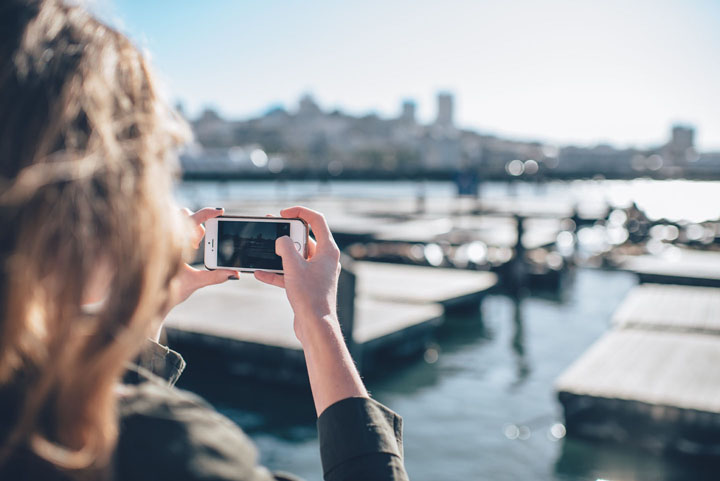When you’re traveling, you need a foolproof way to stay in touch with friends and family back home in the US. Here’s how to call the US from the UK and make an international call for free.
First I always start with finding a dedicated bag or pocket in my carry-on to keep all chargers, cords and tech stuff to easily grab on the move. There’s nothing worse than digging for a cord when your battery is about to run out!

Photo by Ian Schneider on Unsplash
Your smart phone will likely be your go to resource. It serves as your phone and a quick way to pull up boarding passes, maps, hotel, travel info and booking details all in one place. I may complain about the ubiquitous phone but when traveling it’s a must have accessory!
Here’s How to Keep in Touch by Phone When You’re Traveling
- You can take your US cell or mobile with you and add a plan to use it overseas.
- OR if you’re planning on being gone for a month or more, you can buy a local cell phone.
- OR you can use both. I’ll explain further in a bit.
- If your phone is unlocked you can buy a SIM card in the country you’ll be traveling in
1.When you want to take your US cell phone with you:
Most US cell carrier offer plans to take your phone to Europe. I would recommend if you do sign up for one of these plans, use it for data and texting only. You’ll need data to use maps and apps when you’re on the move and don’t have access to Wifi. Texting is a quick way to keep in touch instead of calling. Check with your phone provider to see how many texts you’re allowed. AT&T offered unlimited free texting which is convenient. No one wants to try and keep track of their text usage!
None of the US carriers had reasonable per minute call rates to call home. In fact they’re downright punishing. So take a plan with you for data (and a call home if you absolutely need to) and then get a local phone for calling locally.
International plans with US carriers:
AT&T – offers a daily ($10.) or monthly plan starting at $40. This is what I’ve used. It works well for data and text but calls are $$.
Verizon – offers a daily travel pass and monthly travel plans as well as cruise ship plans. Rates from $10. per day
T-Mobile – Check the country you’re traveling to to find out what they offer for calls within an international country. The T-Mobile 1 plan gives you the option of an included data and text plan while you’re in other countries. Check with T-Mobile. I just switched from AT&T to T-Mobile for this reason.
Sprint – Offers an international plan for data starting at $40. a month. They also offer something called a voice pack for calls.
Check with your carrier before you go to find out what they offer as these plans and rates change often. If money is no object, by all means get the best plan you can to use your phone internationally. It’s easier to carry one phone you’re familiar with that has all your contacts and info at hand.
2. Get a Local Phone in the Country You’re Visiting:
I walked into a Vodafone store in Brighton UK and walked out with a nice little Android phone with Googles’ Chrome browser and mapping ability. For about $30 I got a months worth of data and voice usage and the phone. You can pay for a monthly plan (with no commitment) or pay as you go. For example you can top up your phone with as little as £5. To keep your number active, add a top up. To keep my phone number active until I get back to the UK, I’ve topped it up online (if you don’t do this your number will expire at 6 months of non usage)
Use any mobile provider – Vodafone is just one choice. Basically this is a “pay as you go” phone. Cheap but functional and it gives you the ability to have a local number to give to local businesses, or family. Use it for local calls and data usage; just not to call back home to the US (unless you don’t mind large phone bills)!
By the way, unlike the US, incoming calls as free to the recipient in Europe. Keep in mind if you receive a voice call while traveling from the US or even a voice mail message that will be counted as a call and subject to a charge. For example, both AT&T and T-Mobile charge .20 per minute.
3. Use Your US phone AND a Local Phone
On my last trip to the UK, I used my US AT&T cell phone but ended up buying a cheap “pay as you go” Vodafone phone to have a local number. Wish I had done this at the start of my trip for two good reasons. One, it’s easier to call a local number from a local number and two it’s cheaper.
So you keep your US phone for calling, texting and WhatsApp and you use your local phone for local calls.
4. Get a SIM Card for Your US Cell Phone:
If your phone is unlocked (check with your provider, if you are on a plan chances are it’s locked) you can purchase a SIM card in the country you are traveling to. This replaces the SIM card in your phone along with your US number. You will be able to call and text from your phone as a local. You’ll have to pay for a monthly plan to do this (and chances are you may also be paying for your US plan as well to keep your number). If your phone is locked, you will need to ask your cell provider to unlock it before you leave the country.

Other Options to Stay in Touch by Phone Internationally:
What’s App
My son’s girlfriend turned me on to this app. What’s App is owned by Facebook. You use it exclusively on your phone to call, text or chat with any contact you add. You can add your Facebook friends, or folks from the contacts on your phone. The best part is it’s FREE. The app is free and there’s no cost to make calls.
When you make calls you’re making them over your data or Wifi network. If you don’t have either, you won’t be able to make calls. I discovered this app sucks up a lot of data, and since I had a limited amount to use on my AT&T plan, I made sure to make calls to my honey while I was on the Wifi network at my Airbnb flat.
What’s App fills in the gap. Use it to call home for free. You can download the app from the Apple Store or Google Play.
How to Stay in Touch with Wifi and Email:
Wireless Internet: Having a good Wifi connection will make your life a lot easier. You can keep in touch by email which is free. You’ll find a lot more free Wifi spots in Europe than in the US, however always keep in mind public open Wifi is not secure. For example don’t do your banking while on public Wifi.
Your hotel or Airbnb home from home will likely come with Wifi access. Again if you’re using your hotel internet be aware you’re on an open network and don’t access private information while online. If you’re staying in an individual flat or apartment, you’re likely the only person using that network so you should be secure.
Email Vacation Responder: If you don’t want to be bothered with replying immediately to email, add a vacation responder. This is a message that automatically goes out to anyone who emails you. You can customize the message and length of time it stays active. For example, you may want to say “Jane and John will be out of the country from this date to that date. We’ll get back in touch once we return”. Check your email accounts user settings to turn this on.
If you decide not to use a vacation responder, keep in mind each time you check your mail, you’re using data. Unless you have a plan this can add up. Try to schedule checking mail, sending mail, and using What’s App while on a secure Wifi network.
We all like to stay in touch with loved ones and friends, however if you’re on a vacation give yourself a break and limit your business or non essential communication. That’s why it’s called a vacation!
If you’re ready to relocate, my moving abroad checklist can help you get started.




